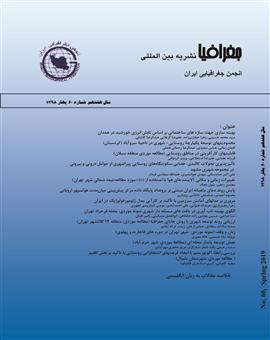الگوی بهینه تاب آوری در بافت های مسئله دار شهری نمونه موردی: محله فرحزاد تهران
محورهای موضوعی :نسا خزاعی 1 , حسین مجتبی زاده خانقاهی 2 , ابوالفضل مشکینی 3 , ناصر اقبالی 4
1 - دانشگاه آزاد تهران مرکزی
2 - دانشگاه آزاد تهران مرکزی
3 - دانشگاه تربیت مدرس
4 - دانشگاه آزاد واحد تهران مرکزی
کلید واژه: تاب آوری, بافت های مسئله دار شهری, محله فرحزاد تهران,
چکیده مقاله :
هدف اصلی از انجام این پژوهش ارزیابی تاب آوری در محله فرحزاد تهران است. برای ارزیابی تاب آوری در ابعاد اجتماعی، اقتصادی و نهادی ـ مدیریتی از تکنیک پرسشنامه و برای ارزیابی تاب آوری در بخش کالبدی، از مطالعات میدانی و نرم افزار GIS استفاده شد. یکی از مهمترین ایدههایی که در دهه حاضر هم در مدیریت بحران و هم در مدیریت شهري مطرح شده است، ایجاد شهرهاي تاب آور و مقاوم در برابر بحرانهای مختلف است. تابآوری شهري را میتوان به توانایی یک محدوده شهري در معرض خطرات مانند تغییرات آب و هوایی، سوانح، فقر اقتصادي و اجتماعی براي مقاومت، جذب، تطبیق به آنها و یا دوري از آنها تعریف کرد. تفكر تاب آوري در سيستم هاي پيچيده مانند شهرها درك پويايي و روابط غيرخطي در اين نوع سيستم ها را ميسر مي سازد. اين تفكر، در بستر اكولوژي شهري مدرن امكان يكپارچه سازي عوامل انساني و اكولوژيكي در سيستم هاي شهري و درك تعاملات بين آنها، بسط راهبردهاي پايداري با توجه به تعاملات شناسايي شده را فراهم مي آورد .امروزه عمدتاً شهرها و جوامع سکونت گاهی در مکان هایی ایجاد یا بنا شده اند که به لحاظ مخاطرات طبیعی در معرض وقوع انواع سوانح طبیعی و یا به دلیل پیشرفت های تکنولوژی در معرض انواع سوانح انسان ساخت هستند. نگاهی که تاکنون در مدیریت سوانح و مدیریت شهری وجود داشته، بیشتر نگاه مقابله ای و کاهش مخاطرات بوده است. در باره ارزیابی های صورت گرفته در زمینه تاب آوری اجتماعی در محله فرحزاد براساس پرسشنامه های تکمیل شده می توان گفت که شاخص تمایل اجتماعی به مشارکت با میانگین 94/3 در رتبه اول قرار دارد. در رتبه دوم شاخص پیوندهای اجتماعی با همسایگان با میانگین 82/3 و در رتبه سوم شاخص توانایی انطباق با آشفتگی ها و تنش ها با میانگین 64/3 قرار دارد. شاخص های مشارکت در تصمیم گیری و میزان مشارکت برای رفع بحران به ترتیب با میانگین های 55/3 و 46/3 در رتبه های چهارم و پنجم قرار دارند. درک محلی از خطر با میانگین 15/3 در رتبه ششم و دانش و آگاهی نسبت به بحران با میانگین 95/2 در رتبه هفتم قرار دارند. در مجموع میانگین تاب آوری اجتماعی در محله مورد مطالعه برابر با 50/3 است که می توان گفت میزان تاب آوری اجتماعی در محله فرحزاد در سطح متوسط قرار دارد.
The main aim of doing this research was to assess the resilience in Farahzad neighborhood of Tehran. In order to assess resilience in social, economic, and managerial- institutional dimensions, questionnaire method was used and in order to assess physical section, field study and GIS software was used. One of the most important ideas that has been going on in current decade about crisis management and also urban management, is to create resisting cities and cities than can resist various crisis. Urban resilience can be described as the ability of an urban area to resist against dangers such as climate change, accidents, economic and social poorness to resist against them, absorb and adapt them or to avoid them. The thought of resilience in complicated systems such as cities, enables the understanding of mobility and nonlinear relations in such systems. This thinking, in the modern urban zone, the ability to integrate human and ecologic factors in urban systems and understanding their interactions, enables the extension of sustainable strategies according to the identified attractions. Today, mostly cities and settlement societies are created or built in such places that in terms of natural disasters are in danger of various of them and or because of technological advances are in danger of human made accidents. The perspective that has been there in management of accidents and urban management, has been mostly conflicting and decreasing the dangers. About the assessments done on social resilience in Farahzad neighborhood, based on the completed questionnaires, it can be said that the social tendency to participate with an average of 3.94 was ranked first. In second rank, is social ties with neighbors with an average of 3.82 and in third rank is the ability to adapt to tensions and chaos with an average of 3.64. Factors of participation in decision making and level of participation to solve the crisis with 3.55 and 3.46 averages in order, are ranked fourth and fifth. Local understanding of danger with an average of 3.15 is on sixth rank and knowledge and awareness of crisis with average of 2.95 is ranked seventh. Altogether, the sum of social resilience in the studied neighborhood was 3.50 which can be said that the level of social resilience in Farahzad neighborhood is at an average level.
